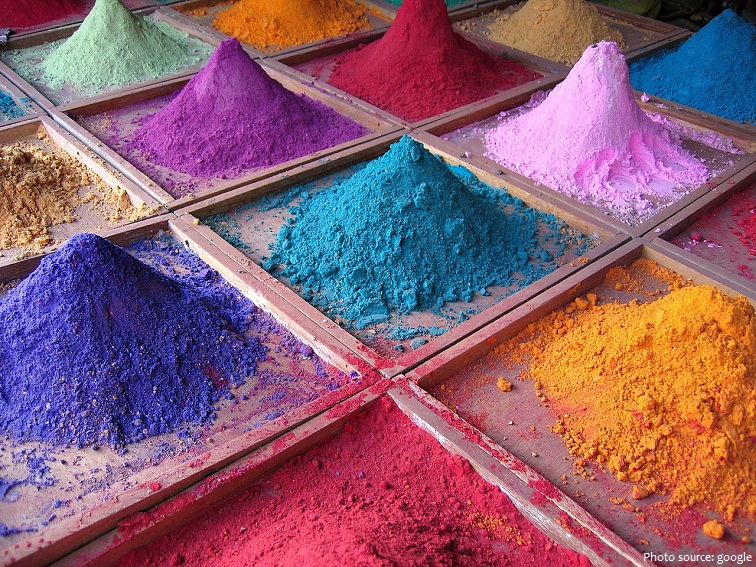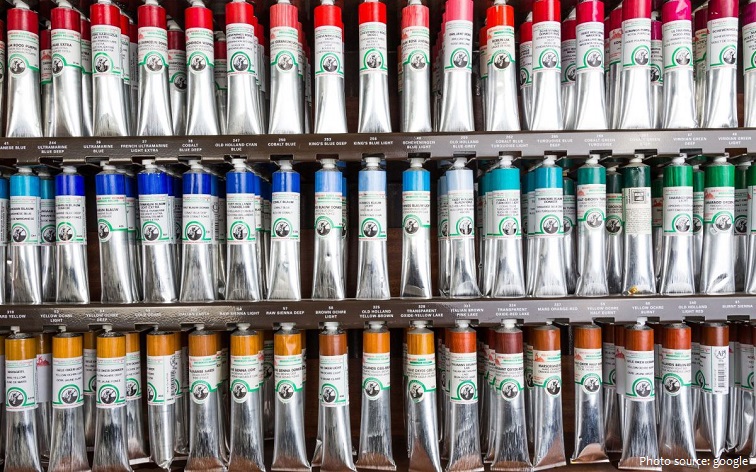
Oil paint is a type of slow-drying paint.
The viscosity of the paint may be modified by the addition of a solvent such as turpentine or white spirit, and varnish may be added to increase the glossiness of the dried oil paint film.
The main advantages of oil paints are their flexibility and depth of colour. They can be applied in many different ways, from thin glazes diluted with turpentine to dense thick impasto. Because it is slow to dry, artists can continue working the paint for much longer than other types of paint. This provides greater opportunity for blending and layering. Oils also allow the
artist to create greater richness of colour as well as a wide range of tonal transitions and shades. In fact oil colours do not change noticeably after drying, and it is possible to produce both opaque and transparent effects, as well as matt and gloss finishes. In the hands of Old Masters like Rubens or Rembrandt oils permitted stunning effects of light and colour as well as much greater realism.

In its simplest form, oil paint is a mixture of three things: pigment, binder and thinner. Pigment is the colour element, while the binder (the oil) is the liquid vehicle or carrier which holds the ground-up pigment to be applied to the canvas or whatever support is to be painted.
Common pigment types include mineral salts such as white oxides: zinc oxide, titanium dioxide, and the red to yellow cadmium pigments. Another class consists of earth types, the main ones being ochre, sienna and umber. Still another group of pigments comes from living organisms, such as madder root. Synthetic organic pigments are also now available. Natural pigments have the advantage of being well understood through centuries of use, but synthetics have greatly increased the spectrum of available
colors, and many have attained a high level of lightfastness.
Traditional oil painting techniques often begin with the artist sketching the subject onto the canvas with charcoal or thinned paint. Oil paint is usually mixed with linseed oil, artist grade mineral spirits, or other solvents to make the paint thinner, faster or slower-drying. (Because the solvents thin the oil in the paint, they can also be used to clean paint brushes.) A
basic rule of oil paint application is ‘fat over lean’, meaning that each additional layer of paint should contain more oil than the layer below to allow proper drying. If each additional layer contains less oil, the final painting will crack and peel. The consistency on the canvas depend on the layering of the oil paint. This rule does not ensure permanence – it is the
quality and type of oil that leads to a strong and stable paint film.

Oil paints were first used in Asia as early as the 7th century AD and can be seen in examples of Buddhist paintings in Afghanistan.
For many years, the first use of oil paint was attributed to the Flemish artist Jan van Eyck, and his brother Hubert. It was their painting skills, it was said, together with their expertise in oil colour pigments, that convinced first the Dutch then the Venetians and then other Italians that oil was superior to egg tempera. Although it is true that the Van Eycks revolutionized the practice of oil painting, and brought it to an early peak of perfection, they did not invent it. Instead, its origins are older and more obscure.
Oil-based paints made their way to Europe by the 12th century and were used for simple decoration, but oil painting did not begin to be adopted as an artistic medium there until the early 15th century.
In the 13th century, oil was used to detail tempera paintings. In the 14th century, Cennino Cennini described a painting technique utilizing tempera painting covered by light layers of oil. The slow-drying properties of organic oils were commonly known to early painters. However, the difficulty in acquiring and working the materials meant that they were rarely used (and
indeed the slow drying was seen as a disadvantage.

In the 16th century, oil colour emerged as the basic painting material in Venice. By the end of the century, Venetian artists had become proficient in the exploitation of the basic characteristics of oil painting, particularly in their use of successive layers of glazes. Linen canvas, after a long period of development, replaced wooden panels as the most popular support.
The paint tube was invented in 1841 by portrait painter John Goffe Rand, superseding pig bladders and glass syringes as the primary tool of paint transport. Artists, or their assistants, previously ground each pigment by hand, carefully mixing the binding oil in the proper proportions. Paints could now be produced in bulk and sold in tin tubes with a cap. The cap could be screwed back on and the paints preserved for future use, providing flexibility and efficiency to painting outdoors. The manufactured
paints had a balanced consistency that the artist could thin with oil, turpentine, or other mediums.
It was only during the 19th century that industrial manufacturers began to produce a proper range of fine art oil paints. Until then, artists made their own paints, which had to be produced fresh each day. Most Renaissance or Baroque painters, for instance, worked for severals years as a pupil (apprentice) in the workshop (atelier) of a master artist, where they studied the skills of drawing (disegno), painting (colorito) and also how to make and mix paint.